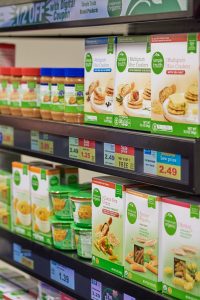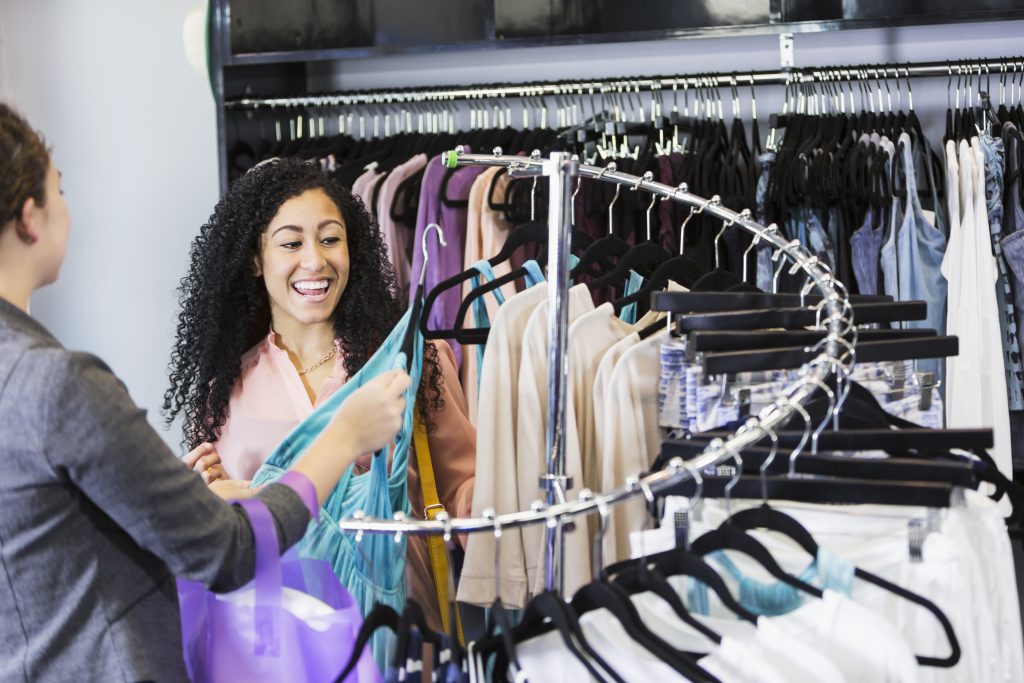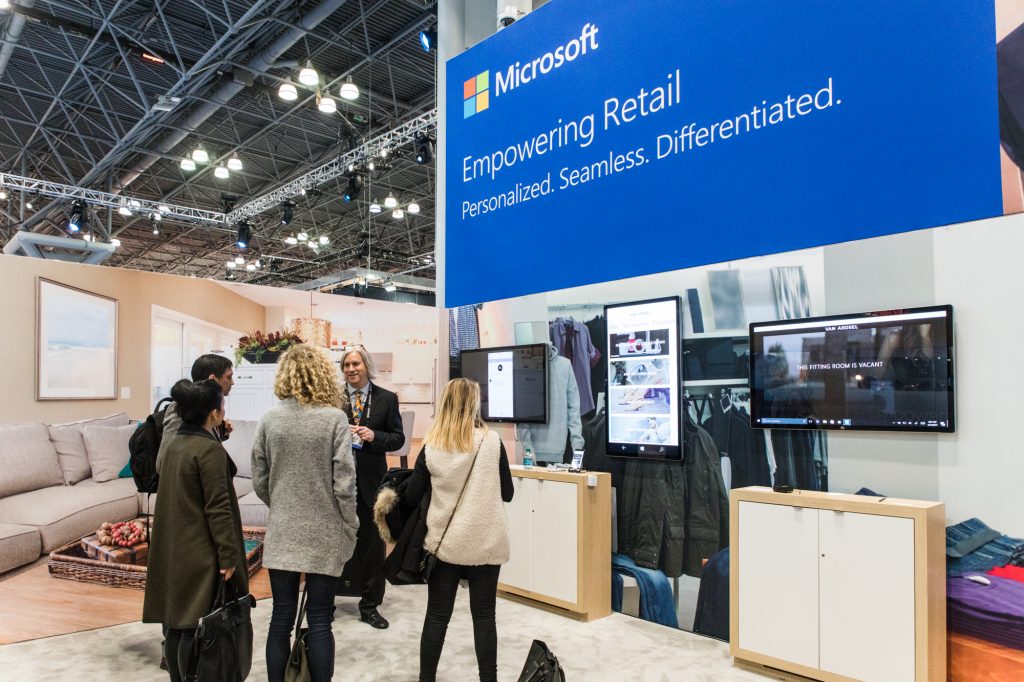Microsoft at the NRF Big Show: There’s nothing artificial about the real intelligence transforming retail
Here’s a small truth we can all recognize: The better experience a retailer gives us, the more we want such experiences everywhere we shop. If we don’t get that great treatment again, we’re a bit disappointed, maybe even peevish. We’ve been spoiled — and we want more spoiling.
The single most important factor in delighting the shopper is data – and more specifically, what retailers do with the volumes of data they have at their fingertips.
For example, we’ve come to expect that an online retailer will tell a shopper what people who looked at the same last three items finally ended up buying — a helpful and persuasive bit of information. But today’s intelligent retailers are using data not just for those anticipated recommendations, but also in new and surprising ways in physical environments.
An astute salesperson in a brick-and-mortar store might take note of a what a shopper has left in his online cart and, when that shopper visits the store, have those items – as well as others that are recommended based on his past purchase history – ready for trying on in a dressing room.
This week at the National Retail Federation’s (NRF) annual show in New York City, Microsoft’s emphasis is on data: what data retailers need, and how best to collect and analyze it. Happily, thanks in part to Microsoft Azure, as well as AI and Internet of Things (IoT) cloud services, wrangling data is becoming increasingly easy and inexpensive for retailers of all sizes.
Armed with the right data, brick-and-mortar stores can more easily offer world-class service that seamlessly spans online and in-person, too. Data-driven control over the supply chain can help maintain just the right levels of inventory. Data can help a store quickly stock items that will sell well because of weather or local events. Knowing a customer’s buying and browsing histories enables helpful purchase suggestions and increases opportunities for upselling.
Here are some examples of retailers innovating with Microsoft technology to make creative use of data, thus winning customers’ hearts, minds and dollars. All are on display in Microsoft’s booth at NRF.
Providing new and personalized experiences
Grocery chain Kroger is collaborating with Microsoft and others to create EDGE (Enhanced Display for Grocery Environment), a grocery-store shelf with a tall vertical front surface that’s a video screen displaying prices, nutritional and allergy information, videos, or other images or data that might boost sales. EDGE relies on Azure to store and process volumes of data.
Connected to both store management and customers by Zigbee, Bluetooth or Wi-Fi, EDGE monitors quantities to ensure stock doesn’t run low. Prices can be set systemically and changed quickly for flash promotions. EDGE can even be programmed to offer sale prices to customers as they pass by, if they’ve indicated they’re interested in a given product and have downloaded an associated app. Now being tested in about 20 Kroger stores, EDGE is set for wider roll-out in 2018.
Ensuring an agile supply chain and empowering employees with omnichannel insight
What’s warm, fuzzy and backed by hidden Microsoft technology? A custom-made stuffed deer, bear, monkey or rabbit from Build-A-Bear Workshop.
Until recently, the global company was using siloed systems that required IT efforts to provide company-wide views of key metrics. Now Dynamics 365 is helping the company build a sturdy, unified IT foundation that will allow for future innovation.
 For example, moving forward – and with the customer relationship management capabilities of Dynamics 365 as the foundation – Build-A-Bear is looking to empower its store employees with Microsoft 365, which will provide them with easier access to training, sales metrics and information to assist in offering the best customer experience possible. All of this will help them focus on doing what Build-A-Bear does best: making kids (and their parents) happy.
For example, moving forward – and with the customer relationship management capabilities of Dynamics 365 as the foundation – Build-A-Bear is looking to empower its store employees with Microsoft 365, which will provide them with easier access to training, sales metrics and information to assist in offering the best customer experience possible. All of this will help them focus on doing what Build-A-Bear does best: making kids (and their parents) happy.
Home-improvement company Lowe’s worked with Silicon Valley-based Fellow Robots to deploy LoweBots, five-foot-tall autonomous robots powered by Microsoft Azure that scan shelf inventory and assist store personnel with inventory data, metrics and shelf intelligence.
Microsoft’s Azure cloud services come into play when processing the large amounts of data that a LoweBot generates while it scans inventory on the shelves. The bot takes high-resolution images and identifies which items are out of stock, misplaced or mislabeled. By keeping constant tabs on inventory, the robot frees store employees to assist customers, and empowers corporate employees to make better and faster decisions when it comes to inventory.
Currently LoweBots are deployed in Lowe’s and BevMo Bay Area stores, but in wider use, its inventorying skills could cut into the $70 billion that U.S. businesses spend each year on inventory management tasks.
Empowering employees with technology
Retail giant Macy’s relies on its Macy’s Technology team to provide in-store systems, e-commerce sites, mobile apps and internal tools that foster innovation and employee engagement to attract top talent and boost productivity. Macy’s uses insights from Microsoft Workplace Analytics and MyAnalytics to help build a culture that focuses on how employees choose to spend their time.
This improved understanding of workplace behaviors allows managers and employees to free up time for creativity and innovation with practices like blocking out focus time and optimizing time in meetings.
Innovating to re-imagine the shopping experience
In a major innovation, software developer Xenia Retail has teamed with electronics giant Philips on a showroom/warehouse-model shopping experience designed to eliminate shopping carts and speed check-out, while allowing retailers to re-imagine what their physical footprint looks like for customers.
Rather than removing an item from the shelf and putting it into the cart, the shopper signals intent to buy by holding his phone up to a product to unveil digital value – such as crowd-sourced reviews and complimentary products – and select the quantity, color or size desired. Check-out is virtually instantaneous and can be completed in the app or via self-checkout on a secure payment terminal.
As carts are built and transacted in the digital realm, orders are picked and packed in real-time by team members in the back warehouse, and fulfilled according to the shopper’s preference. In doing so, retailers can optimize and reduce front-of-house operations to better focus on warehousing and online fulfillments as ecommerce continues to grow.
Xenia is based on Windows and runs on Azure. The company is integrating Power BI, Dynamics 365 and Outlook into its offerings.
To see and interact with these innovations, visit the Microsoft booth (#2803) at the NRF Big Show, and plan to attend our session to hear first-hand from these and other customers who are transforming their customer experiences, operations, employee engagement and products with intelligent technologies.









